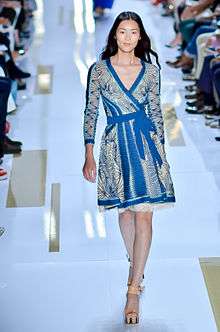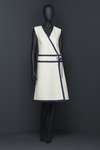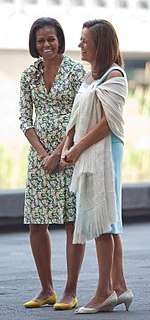Wrap dress

A wrap dress is a dress with a front closure formed by wrapping one side across the other, and knotting the attached ties that wrap around the back at the waist or fastening buttons. This forms a V-shaped neckline and hugs the wearer's curves. A faux wrap dress resembles this design, except that it comes already fastened together with no opening in front, but instead is slipped on over the head. A wrap top is a top cut and constructed in the same way as a wrap dress, but without a skirt.
History

Although it is often claimed that Diane von Fürstenberg 'invented' the wrap dress in 1972/73,[1] Richard Martin, a former curator of the Costume Institute at the Metropolitan Museum of Art, noted that the form of Fürstenberg's design had already been "deeply embedded into the American designer sportswear tradition," with her choice of elastic, synthetic fabrics distinguishing her work from earlier wrap dresses.[2] During the Great Depression, house dresses called "Hooverettes" were popular which employed a wrap design. Wrap dresses were designed by Elsa Schiaparelli in the 1930s[3][4] and by Claire McCardell in the 1940s, whose original 'popover' design became the basis for a variety of wrap-around dresses.[5]

The Fürstenberg interpretation of the wrap dress, which was consistently knee-length, in a clinging jersey, with long sleeves, was so popular and so distinctive that the style has generally become associated with her.[6][7][8] She has stated that her divorce inspired the design,[9] and also suggested it was created in the spirit of enabling women to enjoy sexual freedom.[10] In 2004 a book dedicated entirely to Fürstenberg's wrap dresses was published.[11]
Wrap dresses achieved their peak of popularity in the mid to late 1970s, and the design has been credited with becoming a symbol of women's liberation in the 1970s.[12][13] They experienced renewed popularity beginning in the late 1990s, particularly after von Fürstenberg reintroduced her wrap dress in 1997; she, among others, has continued to design wrap dresses since then.[7][14] The wrap dress's popularity and its perceived feminist significance have remained current into the mid-2010s.[13]
See also
References
- ↑ Grufferman, Barbara Hannah (20 February 2012). "The Wrap Star: Why Diane Von Fürstenberg Is Still On A Roll". The Huffington Post. Retrieved 13 January 2014.
- ↑ Martin, Richard (1998). American ingenuity : sportswear, 1930s - 1970s. New York: Metropolitan Museum of Art. p. 35. ISBN 9780870998638.
- ↑ "Elsa Schiaparelli". Vogue. Retrieved 13 January 2014.
- ↑ Binkley, Christina (April 27, 2012). "Two Divas (One Dead) Talk Fashion". The Wall Street Journal. Retrieved 13 January 2014.
- ↑ Polan, Brenda; Tredre, Roger (2009). The great fashion designers (English ed.). Oxford: Berg Publishers. p. 93. ISBN 9780857851758.
- ↑ Miller, Amanda Christine (January 16, 2008). "Diane von Fürstenberg On Wrap Dresses And The Joys Of Aging Gracefully". Huffington Post. Retrieved June 27, 2011.
- 1 2 "Diane von Fürstenberg". Retrieved 17 July 2012.
- ↑ "Diane von Fürstenberg". Fashion Model Directory. Retrieved June 27, 2011.
- ↑ Borresen, Kelsey (9 November 2012). "Diane von Fürstenberg Wrap Dress Inspired By Designer's Divorce". Huff Post. Retrieved 4 February 2013.
- ↑ Walden, Celia (6 April 2011). "Diane von Fürstenberg: interview". The Telegraph. London. Retrieved 13 January 2014.
- ↑ Talley, André Leon (2004). Diane von Fürstenberg : the wrap. New York, NY: Assouline. ISBN 9782843235245.
- ↑ "Wrap superstar: Designer Diane von Fürstenberg tells her story". The Independent on Sunday. London. March 27, 2008. Retrieved June 27, 2011.
- 1 2 Leora Tanenbaum (July 14, 2015). "Because of Slut-Shaming, the Wrap Dress Still Matters". Huffington Post. Retrieved July 15, 2015.
- ↑ McKean, Erin (2013). The Hundred Dresses: The Most Iconic Styles of Our Time. New York: Bloomsbury. p. 201. ISBN 9781608199761. Retrieved May 6, 2013.
Revived in 1997, the dress again sold in the millions.
External links
| Wikimedia Commons has media related to Wrap dresses. |
- A 1970s von Fürstenberg jersey wrap dress at the Metropolitan Museum of Art
- "Diane von Fürstenberg 'Journey of a Dress' exhibition opens in L.A." by Booth Moore, Los Angeles Times, January 10, 2014